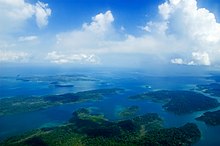Coasts[edit]
The Eastern Coastal Plain is a wide stretch of land lying between the Eastern Ghats and the oceanic boundary of India. It stretches from Tamil Nadu in the south to West Bengal in the east. The Mahanadi, Godavari, Kaveri, and Krishna rivers drain these plains. The temperature in the coastal regions often exceeds 30 °C (86 °F), and is coupled with high levels of humidity. The region receives both the northeast monsoon and southwest monsoon rains. The southwest monsoon splits into two branches, the Bay of Bengal branch and the Arabian Sea branch. The Bay of Bengal branch moves northwards crossing northeast India in early June. The Arabian Sea branch moves northwards and discharges much of its rain on the windward side of Western Ghats. Annual rainfall in this region averages between 1,000 and 3,000 mm (39 and 118 in). The width of the plains varies between 100 and 130 km (62 and 81 mi).[35] The plains are divided into six regions—the Mahanadi delta, the southern Andhra Pradesh plain, the Krishna-Godavari deltas, the Kanyakumari coast, the Coromandel Coast, and sandy coastal.[citation needed]
The Western Coastal Plain is a narrow strip of land sandwiched between the Western Ghats and the Arabian Sea, ranging from 50 to 100 km (31 to 62 mi) in width. It extends from Gujarat in the north and extends through Maharashtra, Goa, Karnataka, and Kerala. Numerous rivers and backwaters inundate the region. Mostly originating in the Western Ghats, the rivers are fast-flowing, usually perennial, and empty into estuaries. Major rivers flowing into the sea are the Tapi, Narmada, Mandovi and Zuari. Vegetation is mostly deciduous, but the Malabar Coast moist forests constitute a unique ecoregion. The Western Coastal Plain can be divided into two parts, the Konkan and the Malabar Coast.
Islands[edit]
See also: List of islands of India
The Lakshadweep and the Andaman and Nicobar Islands are India's two major island formations and are classified as union territories.
The Lakshadweep Islands lie 200 to 300 km (120 to 190 mi) off the coast of Kerala in the Arabian sea with an area of 32 km2 (12 sq mi). They consist of twelve atolls, three reefs, and five submerged banks, with a total of about 35 islands and islets.
The Andaman and Nicobar Islands are located between 6° and 14° north latitude and 92° and 94° east longitude.[36] They consist of 572 isles, lying in the Bay of Bengal near the Burmese coast. They are located 1,255 km (780 mi) from Kolkata (Calcutta) and 193 km (120 mi) from Cape Negrais in Burma.[36] The territory consists of two island groups, the Andaman Islands and the Nicobar Islands. The Andaman Islands consists of 204 small islands across a total length of 352 km (219 mi). India's only active volcano, Barren Island is situated here. It last erupted in 2008. The Narcondum is a dormant volcano and there is a mud volcano at Baratang. Indira Point, India's southernmost land point, is situated in the Nicobar islands at 6°45’10″N and 93°49’36″E, and lies just 189 km (117 mi) from the Indonesian island of Sumatra, to the southeast. The highest point is Mount Thullier at 642 m (2,106 ft).
Other significant islands in India include Diu, a former Portuguese colony; Majuli,[37] a river island of the Brahmaputra; Elephanta in Bombay Harbour; and Sriharikota, a barrier island in Andhra Pradesh. Salsette Island is India's most populous island on which the city of Mumbai (Bombay) is located. Forty-two islands in the Gulf of Kutch constitute the Marine National Park.



No comments:
Post a Comment